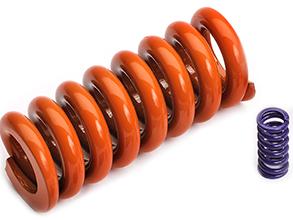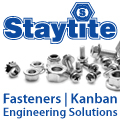
Posted to News on 20th Aug 2021, 08:57
Springboard to the right application
Lee Spring offers guidance to engineers designing assemblies, developing for production or concerned with installation/maintenance

Compression springs are for push applications that compress when a force is applied. They have either closed ends (where the two end coils of the spring are closed and touching) or open ends (where the end coils are open and spaced consistently with the other coils in the spring).
“Different shapes and sizes of compression spring are available to suit the application, such as cone-shaped springs, which are ideal for batteries,” states Lee Spring. “Other spring shapes include hourglass springs, barrel springs and reduced end springs, also other types of compression spring include Die Springs, REDUX Wave Spring and Lite Pressure springs.”
HEFTY solution for heavy stress
A die spring is a compression spring suitable for high stress, medium heavy and extra heavy load applications. The HEFTY Die Springs, available from Lee Spring, is a heavy-duty metal compression spring, which is reports is ideally suited for use in heavy stress and heavy load applications. It is manufactured using round wire and designed to be used as a die spring or as a heavy-duty coil spring.
The REDUX Wave Spring is a compression spring designed for use in applications where space is limited, occupying just 30-50% of the compressed height of a conventional round wire spring. “The REDUX Wave Spring can even reduce the size and weight of the assembly by as much as 50%,” adds the company.
“When your compression spring application requires a high load in a small space, Lee Spring’s Belleville Washers can be the solution. Their conical configuration enables them to support high loads with relatively small deflections and solid heights, compared to helical springs. Belleville Washers are often used to solve vibration, thermal expansion, relaxation and bolt creep problems.”
Low spring rates, low pressure
Lite Pressure springs are compression springs that are suitable for use in applications requiring low spring rates and low pressure. Meanwhile, Bantam Mini Springs feature wire diameters as small as 0.10mm, which is just slightly thicker than the width of a human hair. These mini springs are made from Elgiloy alloy, which is non-magnetic, high strength and corrosion resistant in a number of environments. It also performs well in temperatures of up to 454° C.
Plastic springs offer a number of beneficial properties. Lee Spring has developed the LeeP plastic composite springs range, which are inert and non-magnetic, with “a high strength to weight ratio, excellent corrosion resistance, low flammability, low toxicity and good stability at elevated temperatures”. They are also recyclable.
Extension springs are attached at both ends to other components. When these components move apart, the spring tries to bring them together again. Extension springs absorb and store energy, as well as create a resistance to a pulling force. “It is initial tension that determines how tightly together an extension spring is coiled,” says Lee Spring.
“This initial tension can be manipulated to achieve the load requirements of a particular application. Extension springs are wound to oppose extension. They are often tightly wound in the no-load position and have hooks, eyes or other interface geometry at the ends to attach to the components they connect. They are frequently used to provide return force to components that extend in the actuated position.”
Torque or rotary force
Torsion springs are a helical spring that exerts a torque or rotary force. It is commonly used in hinges, such as in clothes pins, clipboards, swing-down tailgates and garage doors.
Lee Spring offers Constant Force Springs in four Life Cycle ranges. Each spring is a roll of high yield Type 301 Stainless Steel strip, exerting a nearly constant restraining force to resist uncoiling. When the strip is extended, the inherent stress resists the loading force at a nearly constant rate.
If a stock spring series from Lee Spring won’t work for a particular application, a custom spring may be the best option. “Often, in fact, the assembly design or the elements of the application require different physical dimensions, attachments or performance characteristics – in which case the team of engineers at Lee Spring can provide a quick response with prototypes and test samples to ensure that customers receive the right spring for the job at competitive prices and in a timely fashion.”





